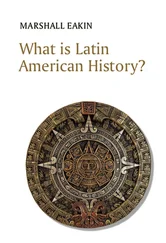From their new base, the Aztecs evolved into ruthless and well-organized warriors. By the 15th century, they subdued and subjugated the peoples of Mexico, thereby creating an empire second in size only to the Incas in Peru. Extending from the Gulf of Mexico to the Pacific and from the Valley of Mexico south into Guatemala, the Aztec empire was peopled mostly by slaves, whose work was supremely manifest in the capital.
As the conquistadors later noted, Tenochtitlan was a city as large as Cordoba or Seville; however, most remarkably, it was situated entirely within Lake Texcoco, two miles from the mainland, Four great causeways led to the city, which was watered by a system of magnificently engineered aqueducts. The streets, lined with splendid temples, issued onto great public squares, which served as marketplaces. And there were priests. Legions of black-robed holy men continually marched through Tenochtitlan’s boulevards, for the Aztec capital was the home of God himself as incarnated in the emperor, Montezuma II.
Splendid though it was, the empire was founded in blood for the purpose of shedding blood. In Tenochtitlan, the temple of human sacrifice was more spectacular than the other temples, sprouting forty towers. There were three main halls, from which various windowless chapels branched. The idols that lined its halls were molded of a paste of seeds and plants kneaded together with the blood of prisoners and slaves taken in battle. Blood was the fuel that drove the Aztec government, economy, and culture. It was said that the very ground of Tenochtitlan was black with it.
Maya civilization was magnificent, and the Aztecs ruled with terrible splendor, but the Incas of Peru controlled the largest native empire in the Americas. Toward the end of the 14th century, the Incas fanned out from their base in the Cuzco region of the southern Andes. For the next century and a half, their holdings increased until the Inca world was invaded by Conquistadors under the command of Francisco Pizarro in 1532. At the time of that clash, the Incas held sway over some 12 million people in what is now Peru and Ecuador, as well as parts of Chile, Bolivia, and Argentina.
The origin of the Incas is shrouded in mystery, but what is known is that they expanded into a New World empire under the ruler Pachacuti. Pachacuti’s sons continued the conquests. One of them, Topa Inca (who reigned from 1471 to 1493), took much of present-day Ecuador, the south coast of Peru, northern Chile, and most of northwestern Argentina, as well as a portion of the Bolivian plateau.
War was a constant Inca activity, but when the Incas weren’t fighting, they were building. The greatest surviving monument of Inca architecture is the citadel of Machu Picchu. Situated on a lofty precipice between steep mountain peaks 7,875 feet above sea level on the eastern slopes of the Andes, the fortified town boasts fine stone buildings with extensive agricultural terraces that make the settlement look as if it had been physically carved. out of the mountainsides.
Beyond the Aztec Frontier
Look at the Americas in the days before the European invasion. What you see are great empires in South and Central America, but, for the most part, a collection of thinly distributed and, in a political and material sense, less highly developed civilizations in North America. In what is now the southwestern region of the United States, the Anasazi (“Basket Makers”) evolved into the people of the Pueblo culture. For many years, these were the people who lived just beyond the Aztec frontier.
Pueblo Culture: The First American Frontier
Archaeologists say that Pueblo culture developed out of the Basket Makers, beginning around A.D. 700. From then until about 1100, these frontier people began using cotton cloth and started building their houses above ground, using stone and adobe masonry. Next, during 1100 to 1300, the modest above-ground dwellings evolved (in some places) into the spectacular multiroom. “apartment” complexes, terraced into the sides of cliffs, which continue to awe visitors to such places as Mesa Verde National Park.
Impressive though the Pueblo culture was, it never became as varied or as advanced as the Native cultures to the south. Even before the Spanish entered the American Southwest in the sixteenth century, Pueblo culture began to decline. Between 1276 and 1299, the Pueblos were devastated by drought and famine. Many migrated to more adequately watered regions in New Mexico and northeastern Arizona. Descendants of the Pueblos—the Zunis, the Hopis, and the Rio Grande Pueblos—still live in these areas.
Far to the northeast of the Pueblos, agriculture was well established in the Mississippi valley by the 1st century A.D. We have already glanced at the burial and ceremonial mounds some of these people left. These cultures eventually reached from the Gulf of Mexico to Wisconsin, and from New York to Kansas. It is believed that the thatched houses built by “Temple Mound” people resembled dwellings found in Mexico, and that their pyramidal mounds harked back to the pyramids of Mesoamerica. For these and other reasons (including similarities in religious ritual and in pottery design), many historians believe that the first Indians of the Mississippi valley and Atlantic coastal regions may have descended from Mayan and other Central and South American immigrants to the northern hinterlands.
However they came to populate North America, the Indians of this vast region developed in diverse ways, creating more than 2,000 distinct cultures. Some of these cultures barely subsisted as hunter-gatherers; others became stable and relatively prosperous agricultural societies.
Unlike the Maya, Aztec, and Inca, these North American groups had no written language and left no historical records, so it is impossible to present a “history” of the North American Indians before their contact with Europeans. In fact, some scholars have gone so far as to suggest that most North American Indians lived apart from linear time, harmonizing their lives with the cycles of the seasons and the biological processes of propagation, birth, and death. Europeans, forever doing and getting, were obsessed with recording events and measuring time. The Native Americans were focused instead on being. Time itself was therefore different for them.
Momentously—and tragically—the time of the Old World would collide with the time of the New. For 400 years, from a clash between “Indians” and Christopher Columbus’s men in 1493 to the massacre of Native Americans by the U.S. 7th Cavalry at Wounded Knee on December 29, 1890, the history of America would be in large part the history of racial warfare between white and red.
The first European contact, some 500 years before Columbus sailed, ignited no great tragedy, however. It seems likely that Vikings reached the Faeroe Islands by A.D. 800, and that they landed in Greenland in 870. The very first Old World dweller to set eyes on the continent of North America was most likely a Norseman named Bjarni Herjulfsson in A.D. 986. But that sighting came as a result of a mistake in navigation. Herjulfsson had been blown off course, and he had no interest in actually exploring the land he sighted.
It was not until the next decade, about the year 1000, that the Norse captain Leif Eriksson led an expedition that touched a place called Helluland (probably Baffin Island) and Markland (most likely Labrador). Most historians believe that Leif—celebrated as Leif the Lucky in the great Icelandic sagas of the 13th century—and his men spent a winter in rude Viking huts hastily erected in a spot abundant with berries and grapes and, for that reason, called Vinland.
Читать дальше












